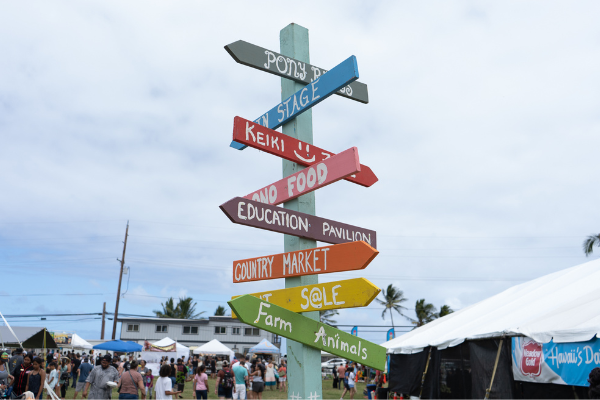Where the Benefits Begin: Defining a Host Community
Jul 28, 2022

Many factors influence the definition of a host community. The project technology, location, and at times, the benefits offered, allow this term to take on different forms. Some define it by communities of interest, some define it by the type of benefits offered, while others don’t care to use the term at all.
Before we continue, it’s important to first consider the implications of using a term like “host community.”
Lauren Ballesteros-Watanabe, an organizer with Sierra Club Hawaii, shared “the usage of ‘host communit[ies]’ is a misnomer that most communities impacted by energy infrastructure, or any development, would use to describe their circumstances.’ It implies that there is a desire, or interest, to willingly welcome development when that is often not the case.”
This perspective highlights the need to be thoughtful about the terms we use, the process used to define these terms, and how these terms, when normalized, may compromise the intended impact of the benefits and who they serve. Ballesteros-Watanabe offered terms such as “disproportionately impacted communities” and/or “infrastructure impacted communities” for consideration, noting that acknowledging historical and present-day context can go a long way.
In Hawaiian Electric’s recent request for proposals (RFPs) for Hawaii Island, Oahu and Maui, the definition of a host community varies by how a developer choose to manage their community benefits. As proposed, developers have the option to either directly fund community identified projects or utilize a nonprofit organization to administer and distribute the community benefits. If developers choose the latter, community members within the same census tracts of the project are then eligible to apply for grants offered by the selected nonprofit.
In light of the above, the examples and considerations offered are intended to help energy stakeholders, developers, and communities define and scope a rather delicate, yet important, component of a Community Benefits Package.
Examples from Other Jurisdictions: New York, Canada, and Australia
In February 2021, the New York Public Service Commission issued an order adopting a host community benefit program, defining a host community as “those within in the town(s) or city(ies) where a Facility is sited.”
In British Columbia, the Government established a First Nations Clean Energy Business Fund eligible only to indigenous communities in British Columbia interested in clean energy projects or planning initiatives.
In Victoria, Australia, Pacific Hydro, an Australian renewable energy company, chose to define a host community based on the needs of a district hospital near several wind farms it owned and operated. The hospital now receives annual distributions from Pacific Hydro’s Sustainable Communities Fund to install renewable energy and energy efficiency measures on their campus.
Place-Based Concepts for Considerations
- Explore alternative boundaries. Neighborhood Boards districts, Renewable Energy Zones (REZs), and the Moku system may be worth considering as potential lines of demarcation or boundaries for defining a host community. In 2005, Hawaiian Electric consulted with the Makakilo/Kapolei/Honokai Hale, Waianae and Ewa Neighborhood Boards in developing a Community Benefits Package for residents impacted by the Campbell Industrial Park Generating Station. More recently, Hawaiian Electric has identified REZs for Oahu, Maui and Hawaii Island, where additional investments in grid infrastructure are needed to accommodate/host additional grid-scale renewable resources. The groups identified in Hawaiian Electric’s recent REZ Study could also be used to inform the scope/definition of a host community. See Figure 14, Figure 20 and Figure 25 of REZ Study for the groups identified by island.
- Consider concentric circles of benefits. Often a host community is defined by the proximity to a renewable energy facility, limiting benefits to those only within the immediate vicinity of the project. As noted in a recent Commission order, “impacts of projects are likely to stretch beyond [census tract] boundaries in certain circumstances,” and nearby communities may also be entitled to benefits. One way to define a host community is to broaden/widen the radius for eligible customers and offer a graduated benefit that decreases with the distance from the renewable energy facility.
- Proportionality should be a key principle. Noting the previous consideration, it is essential that developers ensure, first and foremost, that their definition of a host community does not overlook residents living closest to the renewable energy facility, and therefore, experiencing the greatest impact. This consideration should also be paired with a developer’s consideration to offer benefits above the minimum requirements, particularly in low-to-moderate income (LMI) communities.
- Use a definition that encourages collaboration. Sometimes definitions can have unintended consequences, and in this instance, certain communities may feel excluded from receiving benefits because they do not fit within the definition used by some developers. Developing a definition or standard that provides host communities with incentives to find alignment of community needs and apply for funding opportunities together will be a win-win for all involved.
Host communities play an important role in the success of renewable energy projects. Read last month’s introduction to our Clean Energy Community Benefits Package series, Setting a common agenda for clean energy community benefits, and watch for next month’s story as we delve the specific benefits offered by a Community Benefits Package and examine what kind of benefits are both meaningful to the community and affordable for developers.
Public comments on Hawaiian Electric’s proposed Community Benefits Package or other RFP-related concerns can be emailed to puc@hawaii.gov and should reference Docket 2017-0352, Hawaiian Electric’s Stage 3 RFPs for Oahu, Maui, and Hawaii Island.
Read other entries in our Community Benefits Package series:
- Setting a common agenda for clean energy community benefits (June 28, 2022)
- Exploring benefit sharing options for community benefit packages (Aug. 31, 2022)

